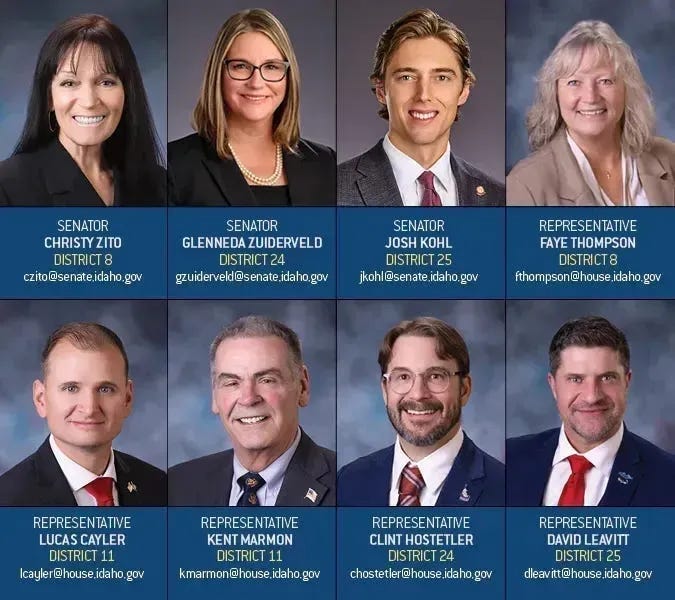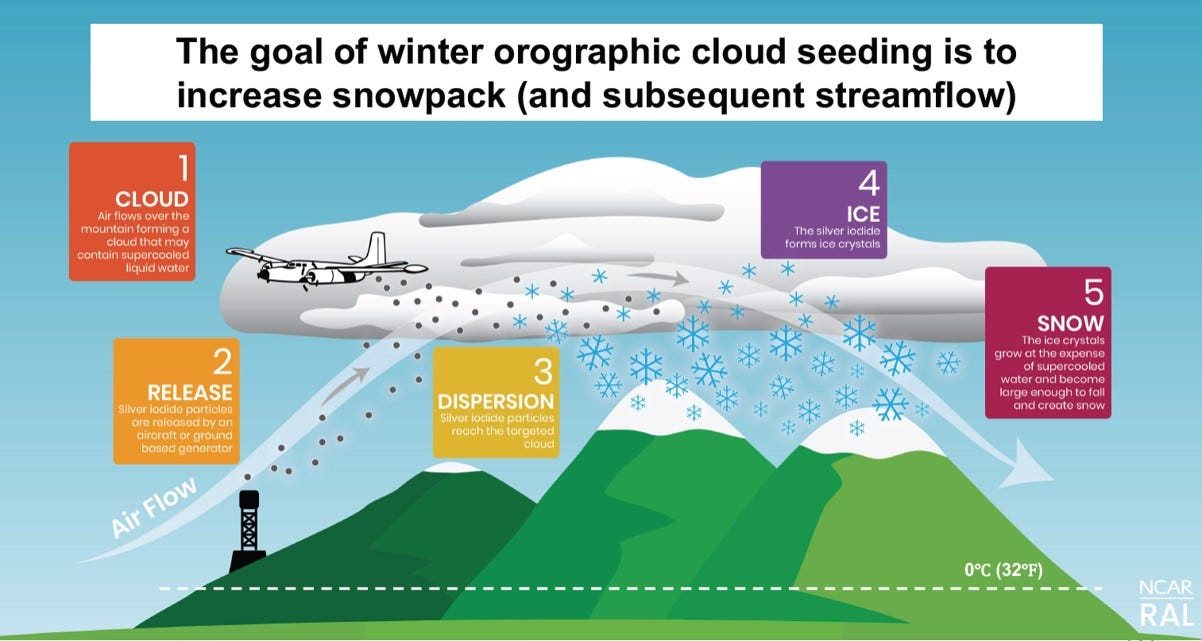Millions into the Clouds—Is Idaho Chasing Storms or Just Spending?
Unproven science, no permits, and millions of taxpayer dollars—what Idahoans aren’t being told about cloud seeding. A message from the Gang of 8.
Idaho’s water is one of our most valuable and tightly managed resources. From irrigation and hydropower to fish habitat and drinking water, we depend on a predictable supply.
That’s why many are looking to cloud seeding as a way to boost precipitation. But before we continue spending millions of public dollars each year on this experimental approach, we need to stop and ask the hard questions:
Does cloud seeding actually work?
Who’s tracking the results?
Why is no one talking about the GAO study that raised major red flags?
What Is Cloud Seeding?
Cloud seeding is a weather modification technique in which planes and ground-based generators release particles into clouds to try to increase rainfall or snowfall. In Idaho, the most commonly known ingredient is silver iodide, but the flares used, especially in aircraft, contain a mixture of chemicals, including ammonium perchlorate (an oxidizer), zinc powder and aluminum powder (fuels), and iodine-based compounds like copper iodide. A typical flare weighs about 150 grams and burns for around four minutes, releasing microscopic particles into the atmosphere that act as artificial ice nuclei.
Idaho has also begun using liquid propane generators placed on high mountain ridges. These units release propane gas into the air, where it rapidly expands and cools, triggering snowfall in storms that are too warm for silver iodide to be effective.
These methods are designed to stimulate precipitation. But what happens when these substances are released repeatedly into the atmosphere and snowfall year after year? That’s a question few agencies are asking. The long-term environmental and health impacts of these chemicals remain largely unstudied.
Idaho Is Spending Millions.
The Idaho Water Resource Board (IWRB) currently spends about $4 million per year on cloud seeding across the state. These operations span the Boise, Wood, Payette, and Upper Snake River basins.
And yet, despite the public investment:
There’s no requirement for permits
There’s no independent evaluation
And the IWRB carries no liability if the program fails or causes unintended consequences
That should raise eyebrows.
Why Cite the Federal Government at All?
We don’t typically look to the federal government as the gold standard for truth. In fact, we’re usually the first to question its overreach, its bias, and its waste.
So why bring up the GAO’s 2024 report on cloud seeding?
Because, for all the bureaucracy, it’s the only comprehensive, multi-agency review of cloud seeding in the last decade, and it doesn’t come from an advocacy group, a vendor with something to sell, or a contractor looking for another state-funded study.
It comes from the federal government’s own watchdog agency, and even they couldn’t find solid evidence that cloud seeding works.
That should tell us something.
What the GAO Found:
The U.S. Government Accountability Office (GAO) released a comprehensive report in December 2024 titled Cloud Seeding Technology: Assessing Effectiveness and Other Challenges. It’s the most detailed national review of cloud seeding in decades.
The report doesn’t claim cloud seeding never works. However, it does raise red flags about the lack of reliable data, inconsistent evaluation methods, and widespread reporting practices that make effectiveness difficult to prove.
“Reliable information is lacking on the conduct of optimal, effective cloud seeding and its benefits and effects.”
Among the key findings:
Most programs fail to show statistically significant results.
The frequently cited 5–15% precipitation increases are based on models or uncontrolled comparisons, not rigorous field trials.
Percent-based reporting is often misleading. For example, a storm that increases from 0.1 inches to 0.3 inches may be labeled a 200% gain, even though the actual increase is minimal.
That kind of math may sell a program, but it doesn’t hold up as sound science.
The GAO’s conclusion? We simply don’t have reliable ways to measure when, where, or how well cloud seeding works, and we certainly shouldn’t treat it as proven policy without independent review and long-term study.
Read the full GAO report here:
Cloud Seeding Technology: Assessing Effectiveness and Other Challenges (GAO-25-107328)
Even Idaho’s Own Studies Came Up Short.
Idaho is often cited as a leader in cloud seeding, but even its most carefully studied project failed to deliver convincing results.
The 2017 SNOWIE project, a federally funded, multi-agency field experiment conducted right here in Idaho, was designed to evaluate seeding effectiveness using advanced radar, aircraft, and atmospheric modeling.
It was hailed as a breakthrough. But here’s what it actually found:
Only 3 out of 27 seeding attempts showed a clearly observed effect.
That means cloud seeding had no detectable impact on precipitation in nearly nine out of ten cases.
So while SNOWIE may have been a scientific milestone in terms of data collection, it also underscores exactly what the GAO report warned about: the science isn’t settled, and the results are far from reliable.
Read the full study here: Tessendorf, S. A., Ikeda, K., Rasmussen, R. M., et al. Precipitation from cloud seeding with silver iodide over the mountains of the western United States: SNOWIE Project Results. Proceedings of the National Academy of Sciences, 117(10), 5190–5195 (2020). https://doi.org/10.1073/pnas.1917204117
What About the Environment?
The GAO also flagged uncertainty around long-term environmental and health impacts:
Silver iodide is mostly insoluble, but it can release silver ions, which may harm soil bacteria and aquatic ecosystems.
Most seeding flares also contain ammonium perchlorate, zinc, and aluminum, yet there is little public awareness and virtually no cumulative impact studies.
As cloud seeding becomes more widespread, no one knows what the downstream effects may be.
Who’s Watching the Watchers?
Oversight is minimal. According to the GAO:
NOAA’s reporting system is outdated and inconsistently used.
Most states, including Idaho, do not require public notification or effectiveness reviews.
Operators often report their own success metrics without independent validation.
This lack of accountability makes it nearly impossible to judge whether taxpayer dollars are being spent wisely or just disappearing into the clouds.
We’re Not Opposed to Innovation—We’re Opposed to Blind Spending.
Idaho needs water. We understand the critical role snowpack plays in sustaining our economy, agriculture, and ecosystems.
However, spending millions of dollars on a program with no proven effectiveness, no liability, no permitting, and no long-term study of its impacts should concern everyone, regardless of political party or position on climate policy.
What Do You Think?
We’re not saying Idaho’s cloud seeding program should end tomorrow, but we are saying it’s time to stop pretending this is settled science. With millions of taxpayer dollars on the line, it’s fair to ask whether the results justify the expense.
We want to hear from you.
Should Idaho continue funding cloud seeding without independent verification or long-term study?
Should the public have more say in evaluating programs that affect our water, land, and skies?
And what solutions would you like to see—more oversight, better data, a pause, or something else entirely?
Your input matters. Let us know what you think.
In Liberty,
Senator Christy Zito, District 8
CZito@senate.idaho.gov
Senator Glenneda Zuiderveld, District 24
GZuiderveld@senate.idaho.gov
Substack: @glenneda
Senator Josh Kohl, District 25
JKohl@senate.idaho.gov
Substack: @joshkohl4idaho
Representative Faye Thompson, District 8
FThompson@house.idaho.gov
Representative Lucas Cayler, District 11
LCayler@house.idaho.gov
Substack: @lucascayler
Representative Kent Marmon, District 11
KMarmon@house.idaho.gov
Substack: @kentmarmon
Representative Clint Hostetler, District 24
CHostetler@house.idaho.gov
Substack: @theidahoresolve
Representative David Leavitt, District 25
DLeavitt@house.idaho.gov
Substack: @leavitt4idaho
Paid subscribers to this Substack will be recorded on Zito For Idaho’s sunshine report as a contribution to a political candidate. Subscribers don't have special access or content. I appreciate your support.







So much evidence of lack of efficacy and possible harms that authorities dismiss as conspiracy theories. Sound familiar?
This — and all other types of weather engineering — MUST STOP 🛑. See also “Cloud Seeding Experiment in Idaho” at https://tinyurl.com/4bup7n46 and “Read the Study” substack at https://readthestudy.substack.com/
Also, please revive a modified version of this bill from 2025, which never received the hearing it deserved: S1065 - Weather modification: https://legislature.idaho.gov/sessioninfo/2025/legislation/S1065/
***
We would remove from S1065 the cloud seeding carve-out and the section about removing the weather modification taxing district, which S1167 took care of after being signed into law.
***
From 1065 Statement of Purpose:
This bill prohibits unauthorized weather modification and solar radiation management activities in Idaho to protect the state’s environment and public health. Weather modification, including cloud seeding and solar radiation management, could have significant negative impacts on agriculture, water supplies, and public welfare if left unregulated.
The bill ensures that only authorized projects, such as those by the Idaho Water Resource Board, are allowed, providing oversight to mitigate risks associated with unauthorized weather manipulation.
Additionally, the bill removes an unused taxing district related to weather modification that has not been utilized since the 1970s, eliminating unnecessary bureaucratic structures.
FISCAL NOTE
This bill does not require any additional funding or resources from the State's General Fund, as it utilizes existing personnel and resources for enforcement and oversight.
Contact: Senator Tammy Nichols, Representative Joe Alfieri
Kill it. Just another joke of a government program. What's next, blocking the sun? Oh wait, ...